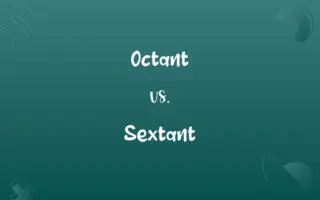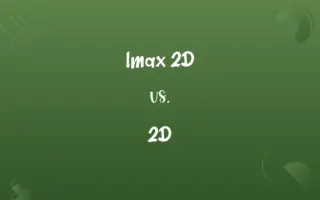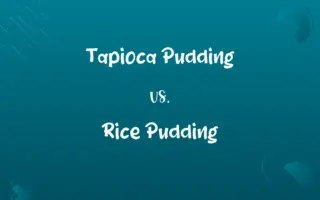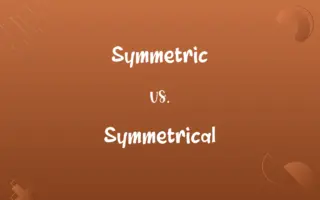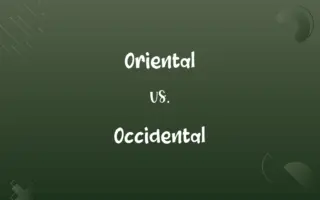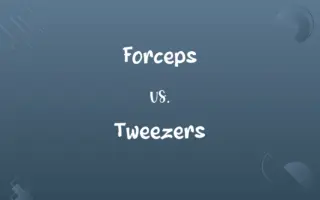Natural Classification vs. Artificial Classification: Know the Difference

By Dua Fatima & Shumaila Saeed || Published on July 22, 2024
Natural classification organisms based on evolutionary relationships, considering genetic, & functional similarities. Artificial classification sorts organisms based on convenience or observable characteristics, not reflecting evolutionary connections.
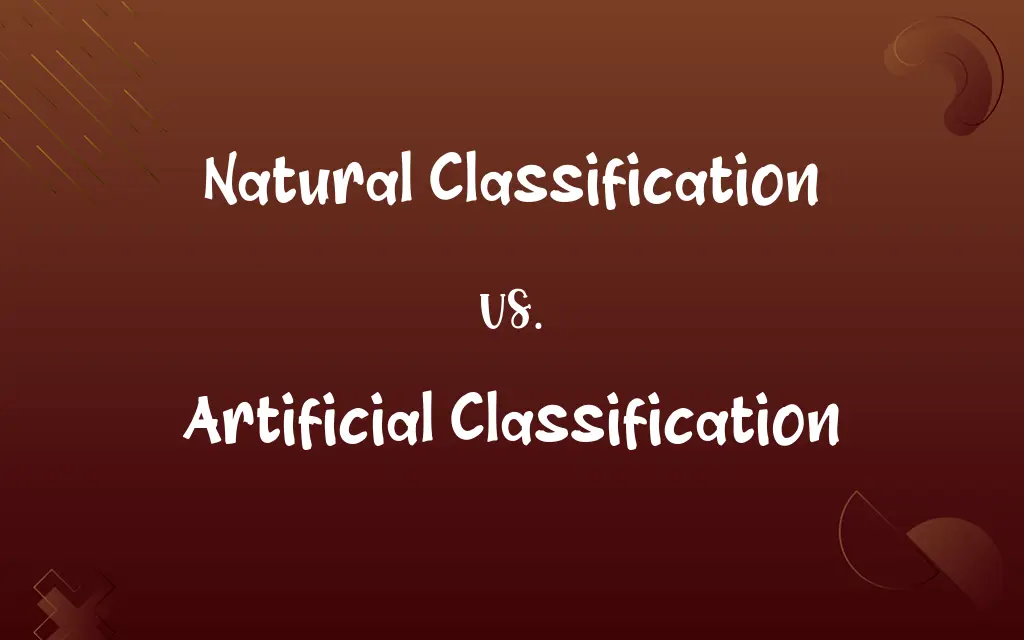
Key Differences
Natural classification is a method that organizes living organisms based on their evolutionary relationships and shared characteristics, encompassing genetic, structural, and functional similarities. Artificial classification, in contrast, simplifies the organization of organisms by focusing on a limited set of observable characteristics, such as color, size, or shape, without considering the evolutionary relationships.
Shumaila Saeed
Jul 22, 2024
Natural classification system, deeply rooted in phylogenetics, aims to reflect the organisms' common ancestry and the pathways of evolution, offering insights into both their differences and similarities. It's a dynamic and complex approach, continually updated with new scientific discoveries, particularly in genetics and molecular biology, which provide deeper understanding of the connections among species. Artificial classification was used before the advent of evolutionary theory and genetic understanding, offering a more straightforward, albeit less accurate, way of categorizing the natural world. It serves practical purposes in certain contexts, like agricultural sorting or in early stages of biological study, but lacks the depth and accuracy of natural classification.
Dua Fatima
Jul 22, 2024
One key difference between the two systems is their foundation; natural classification is rooted in phylogeny, the study of evolutionary relationships, leading to a hierarchical system that mirrors the tree of life. Artificial classification, however, often results in a non-hierarchical arrangement that groups organisms based on convenience or immediate observation, without implying any evolutionary or genetic relationships.
Dua Fatima
Jul 22, 2024
Natural classification has the advantage of providing a more comprehensive understanding of biodiversity and evolutionary history, facilitating scientific communication and research. It helps predict properties of newly discovered species by placing them within an evolutionary context. Conversely, artificial classification, while useful for certain practical applications, can obscure deeper biological connections and may lead to misunderstandings about the nature of the relationships among different organisms.
Hifza Nasir
Jul 22, 2024
The choice between natural and artificial classification depends on the objectives of the classification effort. For scientific research, education, and a deeper understanding of life's complexity, natural classification is preferred. In contrast, artificial classification might still find use in specific, practical contexts where detailed evolutionary relationships are not the primary concern.
Dua Fatima
Jul 22, 2024
ADVERTISEMENT
Comparison Chart
Basis
Evolutionary relationships, genetic similarities
Observable characteristics, convenience
Shumaila Saeed
Jul 22, 2024
Focus
Genetic, structural, and functional similarities
Limited set of observable traits
Dua Fatima
Jul 22, 2024
Hierarchical Structure
Yes, reflects the tree of life
No, often non-hierarchical
Dua Fatima
Jul 22, 2024
Reflects Evolution
Yes, based on common ancestry
No, does not imply evolutionary relationships
Shumaila Saeed
Jul 22, 2024
Usefulness
Understanding biodiversity, evolutionary history
Practical sorting, early biological study
Dua Fatima
Jul 22, 2024
ADVERTISEMENT
Updated with Science
Continually, with new genetic information
Rarely, based on fixed characteristics
Shumaila Saeed
Jul 22, 2024
Predictive Value
High, can predict properties of related species
Low, limited to observed traits
Hifza Nasir
Jul 22, 2024
Natural Classification and Artificial Classification Definitions
Natural Classification
Reflects the tree of life.
The natural classification system organizes species by branching patterns of evolution.
Shumaila Saeed
Feb 29, 2024
Artificial Classification
Lacks evolutionary context.
Artificial classification might group fungi and plants together, ignoring their distinct ancestries.
Shumaila Saeed
Feb 29, 2024
Natural Classification
Updated with scientific discoveries.
Molecular data has refined our natural classification of many species.
Dua Fatima
Feb 29, 2024
ADVERTISEMENT
Artificial Classification
Serves practical purposes.
Gardeners sometimes use artificial classification to organize plants by growth conditions.
Dua Fatima
Feb 29, 2024
Natural Classification
Groups organisms by evolutionary relationships.
Humans and chimpanzees are classified together due to their shared ancestry.
Dua Fatima
Feb 29, 2024
Artificial Classification
Fixed characteristics.
Artificial classification of rocks is based on hardness and color, not formation history.
Shumaila Saeed
Feb 29, 2024
Natural Classification
Considers genetic, structural similarities.
Birds and dinosaurs share structural features, placing them in a natural classification.
Shumaila Saeed
Feb 29, 2024
Artificial Classification
Sorts organisms by observable traits.
Plants were once classified by flower color, an artificial system.
Dua Fatima
Feb 29, 2024
Natural Classification
Predicts species' properties.
By its natural classification, we can predict a newly discovered plant's medicinal properties.
Dua Fatima
Feb 29, 2024
Artificial Classification
Non-hierarchical arrangement.
Artificial systems may group animals simply by habitat, not by relatedness.
Shumaila Saeed
Feb 29, 2024
Repeatedly Asked Queries
What is natural classification?
Natural classification organizes organisms based on their evolutionary relationships, considering genetic, structural, and functional similarities.
Shumaila Saeed
Jul 22, 2024
Why is natural classification preferred over artificial?
It provides a deeper understanding of biodiversity and evolutionary relationships, offering predictive insights and facilitating scientific research.
Dua Fatima
Jul 22, 2024
What is artificial classification?
Artificial classification sorts organisms based on observable characteristics like size or color, not reflecting their evolutionary connections.
Shumaila Saeed
Jul 22, 2024
Can the classification of an organism change?
Yes, as new genetic and evolutionary information becomes available, an organism's classification may be updated, especially in natural classification systems.
Dua Fatima
Jul 22, 2024
How does artificial classification differ in use?
It's primarily used for practical, non-scientific purposes or in early stages of biological study, due to its simplicity and focus on observable traits.
Dua Fatima
Jul 22, 2024
What impact has molecular biology had on classification?
Molecular biology has greatly enhanced the accuracy of natural classification, revealing previously unknown relationships between organisms.
Dua Fatima
Jul 22, 2024
Is artificial classification still used today?
While less common, it's still used in certain practical applications where detailed evolutionary relationships are not the primary focus.
Hifza Nasir
Jul 22, 2024
What role does genetics play in classification?
Genetics is crucial in natural classification, as it provides detailed insights into the evolutionary relationships among organisms.
Shumaila Saeed
Jul 22, 2024
How do new discoveries affect natural classification?
New discoveries, especially in genetics and molecular biology, can lead to revisions and refinements in the natural classification of organisms.
Shumaila Saeed
Jul 22, 2024
Are there any advantages to artificial classification?
Its simplicity and practicality are advantages in specific contexts, like sorting in agriculture or introductory biological education.
Dua Fatima
Jul 22, 2024
Share this page
Link for your blog / website
HTML
Link to share via messenger
About Author
Written by
Dua FatimaCo-written by
Shumaila SaeedShumaila Saeed, an expert content creator with 6 years of experience, specializes in distilling complex topics into easily digestible comparisons, shining a light on the nuances that both inform and educate readers with clarity and accuracy.










